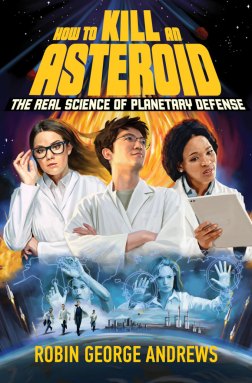How to Kill an Asteroid
Robin George Andrews
W.W. Norton & Co., $29.99
The dinosaurs saw a grisly death at the hands of an asteroid, but who’s to say that Earth’s modern-day inhabitants won’t meet the same fate? Fortunately, scientists are already hard at work to prevent that future. How to Kill an Asteroid by science journalist Robin George Andrews is a deep dive into the extremely badass business of thwarting a destructive asteroid.
The book’s title is a slight misnomer. As Andrews explains, the best strategy to save the planet from an impending asteroid is not to blow it up in space — though that’s a reasonable last-ditch option — but instead to deflect it while it’s still far beyond Earth’s neighborhood. The physics of diversion is tricky: Which spacefaring rocks are harmless and which ones are a real threat? Will scientists be able to detect and intercept one in time? And if we manage to deflect it, will the rock fragment into a gazillion deadly bullets bound for Earth?
Compared with the rest of space exploration, planetary defense has a short history, beginning as a scientific thought exercise in the 1980s and ramping up in earnest in the 1990s. Andrews does an admirable job of packing in details and context about the field. His thorough research brings readers all over the world and across time, from century-past accounts of asteroids striking Earth to recent dress rehearsals of our asteroid preparedness.
Enter DART, short for the Double Asteroid Redirection Test, which put on trial the world’s arguably best concept for a defensive weapon against incoming asteroids. In 2021, the NASA mission hurled a spacecraft toward Dimorphos, a distant asteroid moonlet that poses no threat to Earth, to see whether it could be knocked off course. On September 26, 2022, the spacecraft face-planted onto the moonlet, successfully shoving the space rock off its orbital path (SN: 10/11/22). Andrews frames DART’s tale as a gripping disaster thriller: An asteroid is hypothetically hell-bent on destroying Earth, and it’s up to scientist superheroes to save the world. Though full of suspense, the writing is also at times witty and lighthearted.
But for all of DART’s success, How to Kill an Asteroid presents a somber truth: The DART mission concept is the only tried-and-tested defensive strategy humankind currently has in its anti-asteroid arsenal. The world sorely needs more. And when it comes to developing a planetary security system, we humans may be our own worst enemy.
Indeed, the real challenge isn’t in the science, but rather the bureaucratic hurdles to sign off on asteroid-hunting projects, Andrews explains. While humankind has a potential asteroid defensive strategy, we lack an up-to-the-task asteroid detector. Languishing on the drawing board is NASA’s NEO Surveyor, a space observatory and asteroid specialist whose fate has become uncertain after a crucial budget cut in 2022. The world has also lost a key space sentinel. Besides being an important instrument for space science, the Arecibo Observatory, which collapsed in 2020, was also one of Earth’s best watchdogs for suspicious asteroids (SN: 11/19/20).
Beyond building the instruments to detect and deter cosmic cannonballs, asteroid preparedness also involves taming the geopolitical, social and economic fallout, Andrews writes. If an asteroid one day hurtles toward Earth, human fears and foibles may complicate matters. Once sky watchers sound the alarm, humankind’s collective anxiety could upend everyday life long before the asteroid makes landfall or is successfully diverted. Experts have floated several doomsday scenarios that the world may need to prepare for. For instance, rampant misinformation may trigger insurance scams and crash stock markets. Countries might jump-start their nuclear development programs under the guise of flinging weapons at the asteroid. Other nations might take advantage of the chaos to invade their neighbors. The world might see mass migration out of the predicted ground zero.
Nevertheless, How to Kill an Asteroid is overall more hopeful than fear-stoking. It reminds us that the world has no shortage of ideas for how to thwart an asteroid strike. And it is a rallying cry for a reinvestment in planetary defense programs to ensure we’re ready for the real thing. Scientists are already more than eager to help.
Buy How to Kill an Asteroid from Bookshop.org. Science News is a Bookshop.org affiliate and will earn a commission on purchases made from links in this article.


